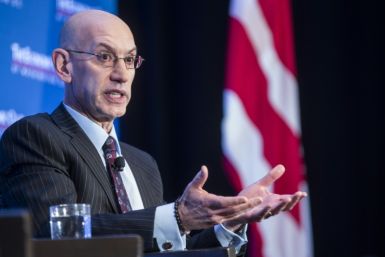The Federal Reserve’s Minutes Add to the Confusion
With the world depending on money printing to keep turning, the Federal Reserve's July minutes were bound to be all important. Or not...
After all the pent up anxiety, the release last night was anticlimactic. 'We know little now that we didn't know going into the release of the minutes,' said Dave Meger, director of metals a Chicago trading firm quoted at News.com.au.
That's another way of saying everyone is still confused about what's going to happen. In fact, some people can't even make heads or tails of what is happening right now. A News.com.au article displayed that confusion nicely. Its headline was 'Gold falls as FOMC offers few clues' and its opening sentence began with 'Gold prices have turned higher after...'
The media is really struggling with financial news these days. But so are financial markets. Obviously nobody had a clue what to make of the minutes as the S&P500 tumbled, surged and tumbled again after the minutes were released at 14:00:
A Confused S&P500
Source: Yahoo Finance
Even though the Federal Reserve's plans may not have changed, it's important to keep in mind what they are in the first place. Well, according to the minutes, the plan is to cut back Quantitative Easing when the economy improves. Apparently, that's going to happen in the second half of 2013.
An improvement in the US economy has been just around the corner since we first joined Port Phillip Publishing more than three years ago. So good luck with that.
Some of the Federal Reserve's money printers and rate riggers (the Federal Open Market Committee) reckon QE should be pared back even if the economy doesn't improve. They're pointing out that $85 billion a month pumped into an economy has the potential to create 'distortions'. If they're right, the distortions would already be there after years of money printing, so we're not sure what they're getting at.
More interesting is a point made by Goldman Sachs. If the Federal Reserve does reduce QE, and that's a big if, how will they do it? It's not just a question of how much. You see, the Federal Reserve is buying around $40 billion Mortgage Backed Securities (MBS) a month as well as US government bonds. If it reduces QE, in what combination of the two will purchases fall?
The difference is important because, right now, the Federal Reserve is basically funding the US government's issuance of new debt. Without the Fed buying Treasuries (government bonds), yields could go through the roof even more than they have been recently. But if the Fed stops buying MBS, that could pull the pin on the all important housing recovery.
Goldman Sachs supposedly reckons that the Federal Reserve will reduce Treasury purchases first. That's because of recent academic evidence that the MBS purchases are much more effective at stimulating the economy. But in a world where Treasury yields are surging, a cut in Treasury purchases would be dangerous to financial stability. Banks, funds, derivative markets and just about every other financial institution and exchange rely on a stable Treasury market. Even US mortgages are tied to 10 year Treasury yields, so the housing recovery could be in trouble either way.
In an environment where a central bank is so involved in the economy, these dilemmas are bound to pop up. As an investor, you're stuck with them sucking up your attention and brain power.
But every now and then, it's important to take a step back and look at things from further afield. What's really going on here is an attempt at central planning - something we know fails with disastrous consequences. The last attempt to influence the economy in such a way came via a housing bubble. This attempt comes via sovereign debt. So where do you think the next crisis will be?
(Hint: It's already begun in Europe.)
In his latest weekly update, the brilliant value investor John Hussman drew attention to a quote in an older update: 'Faith in central banks today is equivalent to faith in the word dot-com in 1999 or faith in the eternal rise of housing prices in 2006.'
That faith is also reaching remarkable proportions, as Hussman points out: 'The first is the dramatic rise in investor confidence in Bank of America's weekly survey. A net 72% of respondents said they expect growth to accelerate over the next year.'
This overconfidence leads to risky bets: 'The second is the $377 billion in margin debt on Wall Street - just below its all-time high... and well above its highs before the dot-com crash and the collapse of Lehman Brothers.'
Hussman's point here is that a sudden drop in the stock market is baked in because people are overoptimistic and highly possible because people are leveraging their bets - not a good combination.
After seeing the results of a housing bubble in Europe and the US, it's odd to see central banks get away with such vast amounts of interference in the economy. Why do people still think it's a good idea to meddle with interest rates and the money supply when it got us into this mess in the first place?
The answer can be found in 18th century medicine. Do you recognise this device?
Probably not, because it's no longer as popular with medical practitioners as it was. It's about as useful as what central bankers call Permanent Open Market Operations, or POMO for short.
POMO is how a central bank controls the interest rate and the money supply. The idea behind it is that you can keep an economy stable by controlling how expensive it is to borrow money, and how much inflation there is.
Central bankers use POMO to make sure the economy's debt is manageable and few people are 'underwater' on their debt - they don't owe more than their house or business is worth. That's where the inflation comes in; it reduces your debt burden by increasing asset and consumer prices.
Our mystery device is an 18th century cure for drowning of a literal sort. And it also involves inflation of a literal sort too. But it works in much the same way as POMO. You pump it up when you're trying to revive people who are 'underwater'.
The thing is, where you do the pumping is crucially important for both POMO and the cure for drowning. And exactly what you pump matters too. In the case of our mystery device, the cure for drowning is in fact a tobacco smoke enema. Here's an earlier model in action, in case you find this difficult to picture:
We don't know if the particular attempt depicted was successful. But the cure was popular. About as popular as POMO is today.
What's odd about the cure for drowning and POMO is where they seek to pump in the inflation. And what they pump in. Both pump the wrong stuff into the wrong end, you might say.
Under POMO, central banks don't pump money directly into the economy where it's needed. They pump 'bank reserves' it into the banking system. Under normal conditions, that's just an advantage for the banks. They get the new money first.
But when the economy is struggling with too much debt and people are 'underwater', there is a blockage in the banking system. It's stopped lending, so adding to reserves doesn't help. Blowing inflation into the banks is about as useful as giving a tobacco enema to a drowned person with constipation. It doesn't work on any level.
Instead, the central bank should be pumping the inflation elsewhere. Namely to the debtors, not the creditors.
Bait-and-tackle shop owner Leonard Maull from Lewes, Delaware showed them how it's done. (POMO, not the drowning cure.) His dying wish was to have $10,000 in small bills dropped from a helicopter above his hometown.
Then again, all this sort of misses the point. Tobacco enemas don't work...to cure drowning anyway. POMO doesn't work to save an underwater economy. As Hussman points out, there is no evidence that higher stock markets improve the economy, and that's about all QE is achieving.
Also, even 18th century doctors knew you shouldn't mess with a healthy patient to keep him healthy. It would just increase the risk of him getting sick. And yet our modern central bankers are fiddling with interest rates and the money supply all the time. Imagine if a person wanted to give you a tobacco enema when you weren't even wet. It just wouldn't make sense.
Doctors and economists are both very lucky in a way. Their profession never allows for controlled experiments, so they can never be proven wrong. Economists call it the lack of a counterfactual. You can never know what would've happened if a policy or cure hadn't been implemented, so all policies look like they work.
That's how smoke enemas became so popular. The same goes for POMO. Back in 2009, Bernanke explained that, had the Federal Reserve and government not saved the economy, it would've collapsed. To add some measure of credibility to his claim he added 'like it did during the Great Depression'.
To understand how stupid this logic is, here's how Wikipedia documents the same belief came about for tobacco enemas, with references to medical journals:
'Richard Mead was among the first Western scholars to recommend tobacco smoke enemas to resuscitate victims of drowning, when in 1745 he recommended tobacco glysters to treat iatrogenic drowning caused by immersion therapy. His name was cited in one of the earliest documented cases of resuscitation by rectally applied tobacco smoke, from 1746, when a seemingly drowned woman was treated. On the advice of a passing sailor, the woman's husband inserted the stem of the sailor's pipe into her rectum, covered the bowl with a piece of perforated paper, and "blew hard". The woman was apparently revived. In the 1780s the Royal Humane Society installed resuscitation kits, including smoke enemas, at various points along the River Thames, and by the turn of the 19th century, tobacco smoke enemas had become an established practice in Western medicine, considered by Humane Societies to be as important as artificial respiration.'
Hopefully central bankers around the world are reading this. Then again, they'll probably reach the opposite conclusion to you - all you have to do to get inflation going and revive the economy is 'blow hard'.
Regards,
Nick Hubble+
for The Daily Reckoning Australia






